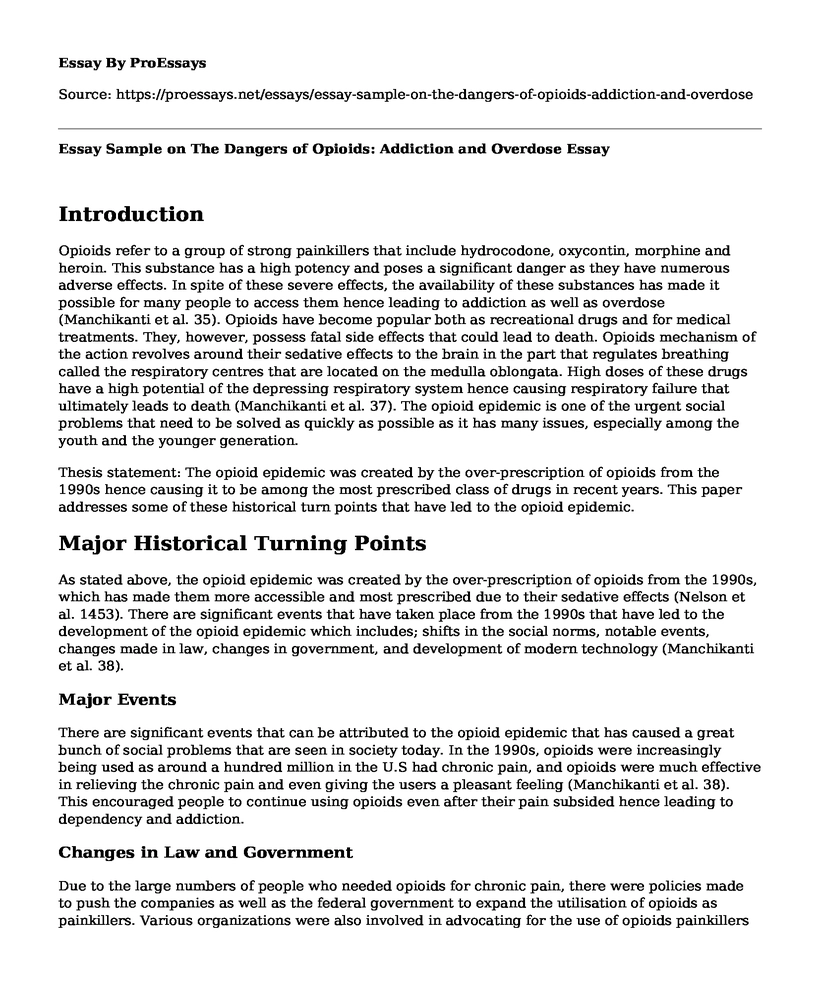Introduction
Opioids refer to a group of strong painkillers that include hydrocodone, oxycontin, morphine and heroin. This substance has a high potency and poses a significant danger as they have numerous adverse effects. In spite of these severe effects, the availability of these substances has made it possible for many people to access them hence leading to addiction as well as overdose (Manchikanti et al. 35). Opioids have become popular both as recreational drugs and for medical treatments. They, however, possess fatal side effects that could lead to death. Opioids mechanism of the action revolves around their sedative effects to the brain in the part that regulates breathing called the respiratory centres that are located on the medulla oblongata. High doses of these drugs have a high potential of the depressing respiratory system hence causing respiratory failure that ultimately leads to death (Manchikanti et al. 37). The opioid epidemic is one of the urgent social problems that need to be solved as quickly as possible as it has many issues, especially among the youth and the younger generation.
Thesis statement: The opioid epidemic was created by the over-prescription of opioids from the 1990s hence causing it to be among the most prescribed class of drugs in recent years. This paper addresses some of these historical turn points that have led to the opioid epidemic.
Major Historical Turning Points
As stated above, the opioid epidemic was created by the over-prescription of opioids from the 1990s, which has made them more accessible and most prescribed due to their sedative effects (Nelson et al. 1453). There are significant events that have taken place from the 1990s that have led to the development of the opioid epidemic which includes; shifts in the social norms, notable events, changes made in law, changes in government, and development of modern technology (Manchikanti et al. 38).
Major Events
There are significant events that can be attributed to the opioid epidemic that has caused a great bunch of social problems that are seen in society today. In the 1990s, opioids were increasingly being used as around a hundred million in the U.S had chronic pain, and opioids were much effective in relieving the chronic pain and even giving the users a pleasant feeling (Manchikanti et al. 38). This encouraged people to continue using opioids even after their pain subsided hence leading to dependency and addiction.
Changes in Law and Government
Due to the large numbers of people who needed opioids for chronic pain, there were policies made to push the companies as well as the federal government to expand the utilisation of opioids as painkillers. Various organizations were also involved in advocating for the use of opioids painkillers such as the Joint Commission that was pushing for increased attention of the physician to respond to the pain of the patients as the pain was termed as one of the five vital signs. These events by the government and other organisations exacerbated the increasing number of opioids that were being prescribed by physicians to patients. Statistics show that between the year 1991 and the year 2011, opioid painkiller prescription in the United States has tripled from merely seventy-six million to over two hundred million prescriptions per year. As of the year 2016, more than three hundred million opioid prescriptions were written per year (Manchikanti et al. 38). This has led to an increase in the volume of opioid medications that are being prescribed hence leading to the rise in the number of substance abuse admissions for treatment and opioid-related deaths.
Shifts in Social Norms
There are shifts in social norms that have contributed to the opioid epidemic. Physicians who are meant to protect people from harm are a significant contributor to the opioid epidemic. In the modern era, some physicians prescribe or even sell opioid medications to people who use it for recreational and not medicinal purposes. The other shift in the social norms is that opioids have become popular among adolescents and school going children as using drugs has been branded as 'coolness'.
Development of New Technologies
New technologies such as new means of communication have brought many good things. However, there are a few unwanted practices that have been facilitated by these innovations such as the worsening of the opioid epidemic as individuals are now able to communicate and link up with their "dealers easily". The technology has eased the procedure of getting opioids and other drugs of abuse as people can link up on social media or through the internet.
Conclusion
The opioid epidemic was created by the over-prescription of opioids from the 1990s, and the problem has worsened over the years. As discussed above, various turning points have played a significant role in this gradual exacerbation which includes; shifts in the social norms, notable events, changes made in law, changes in government, and development of modern technology (Murthy3413). If the problem continues, there will be more problems that will be associated with the opioid epidemic since more complications will develop in ever a better population. There will be increased opiate addiction, tolerance, dependence, withdrawal symptoms, death, as well as social problems such as school dropout, increased crime rates, among others.
Cite this page
Essay Sample on The Dangers of Opioids: Addiction and Overdose. (2023, Jan 16). Retrieved from https://proessays.net/essays/essay-sample-on-the-dangers-of-opioids-addiction-and-overdose
If you are the original author of this essay and no longer wish to have it published on the ProEssays website, please click below to request its removal:
- Critical Essay on Positive Psychology
- Article Analysis Essay on Profiling Mexican-American Identity
- Ethical Conflicts in the Medical Field - Essay Sample
- Research Paper on Retinoblastoma: Common Eye Cancer in Young Children
- Essay Example on Maintaining Normal Body Functioning: Gas, Liquid & Solid Waste Removal
- Essay Example on Ventilator-Associated Pneumonia: Common Hospital-Acquired Disease
- Behavioral Interviews: Predicting Future Success - Free Report Example







